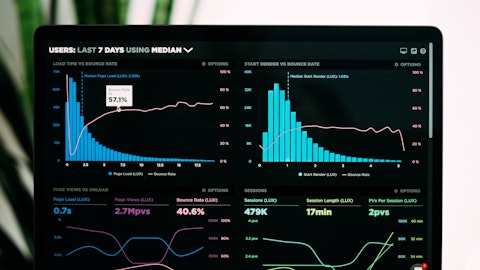Paddy Srinivasan: Yes. Hey, Josh. There’s no factored in price increase as part of our outlook. And just my philosophy is, we will continue to have packaging changes and lineup changes, and we will introduce new products and premium capabilities and things like that, but nothing which is already baked into our outlook for this year. And my philosophy is, we’ll continue – we have to innovate and try new packages and different thresholds and things like that. So it’s an ongoing thing. And as with any other technology vendor, we will pay close attention to what our customers are asking for. So that’s my overarching philosophy.
Josh Baer: Perfect. Thanks.
Operator: And we will take our next question from Pinjalim Bora with JPMorgan. Your line is open.
Pinjalim Bora: Oh, great. Thanks for taking the questions and welcome, Paddy. Just two part, one question on Paperspace. Anyway to understand kind of the adoption of the MLOps platform versus the IAS [ph] side of Paperspace? Is the MLOps platform landing with customers? Are they using that more versus the IAS side of things? And Matt, maybe help us understand. You are, I think, assuming about 6 million from Paperspace this year, was that – did that land at that point, about 6 million, or was it more?
Matt Steinfort: I can start. Thanks, Pinjalim. I’ll start. It’s Matt with the latter question. Yes, we came in right, exactly what we had expected. We had signaled, I think around 5 million, and we came in around 6 million for the year. And clearly on an ARR basis it’s higher than that. That was just the last six months of the year, and we think that, again, that business should give us three points of growth on the entire business. So it’s more than doubling on an ARR basis over the course of this year.
Paddy Srinivasan: Yes. And to answer your first part of your question, I think it’s a mix of both, right? So the MLOps platform needs a steady dose of infrastructure. And as we go into this year, as we start bringing the two platforms closer together, we expect a lot of our Paperspace or AI/ML customers to start consuming more of the DigitalOcean compute capabilities as well. So it’s still early days. It’s a little – so there are customers that are very heavy users of the AI/ML stack, and they might use a little bit of compute on an as needed basis. But then there are other customers who are in a steady state inferencing type of workload. So it is still a little training heavy, as you would expect, given the nature of what customers are trying to do with AI/ML.
And many of our customers are in core use cases like text to image generation or text to video generation and those kinds of things. So it’s a very heavy training oriented mode where it is a lot more of the AI machine learning ops, marshalling data, getting their data set organized, and just training the data set is what we are seeing a lot more of now. But once you get to the steady state is where the spillover to the compute side is about to happen in the inference stage. So that’s why we’re getting ready with our integration of the core DO infrastructure.
Pinjalim Bora: Thank you.
Operator: And we will take our next question from Tim Horan with Oppenheimer. Your line is open.
Tim Horan: Thanks. Just a few clarifications, Matt. I think you said 50 million on GPUs this year. It’s one third. So are you guiding to CapEx closer to 150 million for the year? And if so, how does that square with 20% free cash flow margins? Maybe I’m just missing some adjustments. And can you just give us some color on the outlook, [ph] the demand for GPUs? How confident are you that you can utilize that 50 million in GPUs? Thanks.
Matt Steinfort: Yes. So the guide for the year for free cash flow is 19 to 21. So kind of 20 in the middle. It’s consistent with we’re not guiding to CapEx. I gave you general parameters of it so you can kind of sort it out. But we’re pretty confident in our ability to hit that 19% to 21% free cash flow margin. As we demonstrated this year, we have the opportunity to drive material kind of leverage in the core DO platform, and we can use that to offset the incremental investments that we’re making in both OpEx and CapEx in the Paperspace business. From a demand standpoint and this gets back to, I think, Pinjalim’s question before, which is, did we exceed what we thought we would do in revenue for AI/ML in 2023? Part of this is there’s supply constraints, so you have to order the gear six, nine months in advance to be able to get GPU capacity.
And even when you do that, the vendors, and these are major kind of tier-1 distributors, not kind of small shops, even then, they can’t guarantee that you get it all and you get it all at the right time, and you get it all with all the right parts. And so there’s a more of a –it’s more of a supply challenge right now, to be honest with you, than a demand challenge. It’s like, can we get it? Can we get it installed? Can we get it up and running? And we’re also, again, very focused on the software side of things, which is an integration that we’re doing between our platforms. And so it’s a – we’re not worried at all about the demand. We’re worried about how quickly we can get it turned up and available. And when you’re starting, again, a business from this small size that when we acquired Paperspace, if you turn something up two months later in the month than you had anticipated, that’s a big hit on the – in year revenue, which we’re not that fussed about.
But that’s why we’re, I think, being conservative in terms of the amount of revenue that we’re going to drive off that capital in 2024.
Tim Horan: And then, Paddy, can you – and all the due diligence you did, can you talk about who you think your primary competitors are? And Akamai acquired Linode, and they seem to be more focused on R&D and enterprise than SMB. Do you think competitive intensity is decreasing or do you expect it to? Or do you expect it to increase? Thanks.
Paddy Srinivasan: Yes. That’s a good observation. So yes, I think the competitors are who all of you can guess, right? And I feel when we are looking at our competitive posture, I’m always – I have a very healthy dose of founders paranoia. So I feel like every dollar has to be earned, every customer has to be earned. So we will go with the assumption that all of our competitors are fiercely coming after our customers. So I think that’s the way I like to operate and push our teams to make sure that our innovation outpaces our competition and also out delivers in terms of ease of use and the ability of our platform to stand on its own and impress our customers. So, yes, Akamai/Linode, I have also heard what you just said, but that’s not to say that they might not change their strategy in the next few quarters.
So we like to operate, or I like to operate with that philosophy. So – and same thing for AI/ML. It’s – everyone is throwing the kitchen sink at this problem. But as Matt and I have been repeating ourselves over the last hour, we’ll focus on, yes, hardware is an essential means to an end, but our long-term durable differentiator is going to be on the software stack.
Tim Horan: Thank you.
Operator: And we will take our next question from Jim Fish with Piper Sandler. Your line is open.
Quinton Gabrielli: Hey, this is Quinton on for Jim Fish. Thanks for taking our question, and Paddy, look forward to working with you. Paddy, maybe for you, you talked about a focus on augmenting the self-service motion, investing more in a direct customer relationship. Is that something that’s going to require a further increase in the sales rep headcount as we look to 2024? Or is this more of a rebalance of the existing resources within the sales team?
Paddy Srinivasan: Yes. So it is – it is a factored into the outlook that Matt gave. So, yes, it is a rebalance, and we are not talking about building an army of salespeople, right? So, our customers are developers, and we have to – this is, again, going back to my core philosophy of we really need to be world-class in understanding our customers and their preferences and how they want to be reached, and so we are not going to start dialing for dollars and call our customers day in and day out. That’s not what I’m talking about at all. But there are customers that are reaching a certain point in time of sophistication and requirement from our platform, which A, requires the platform to be rich, and number two is tasteful customer success and ongoing relationship to make sure that they’re getting the best value from our platform, and many of our customers don’t even know the breadth of or how much we have evolved since they started their journey with us.
So, I think it’s a great opportunity for us to wave the flag and make sure that we are engaging with them in a very scaled manner, so – and also using technology to make sure that we are establishing that relationship at the right time with the right set of tools to raise the visibility and offer them help on an as-needed basis. Matt, I don’t know if you wanted to add any color on the actual expense outlay.
Matt Steinfort: No, you nailed it, Paddy. The plan we have already factors in the refactoring and kind of investment in the sales and marketing part of the guide.
Quinton Gabrielli: Very helpful. Then maybe a quick follow-up. Matt, I think it’s for you. We’ve talked about in the past crypto being a headwind to top line. We’ve seen a little bit of improvement in the underlying pricing. Has that correlated to any sort of return in usage on the platform, or maybe what are you seeing from that specific vertical? Thank you.
Matt Steinfort: Yes. We’ve looked exactly at that for the reasons that you described, and we haven’t seen nearly the kind of surge that we had seen in the past. We are seeing, as I said, more usage on the platform, and we saw increasing kind of usage patterns in January. We’re seeing that increase in February, but it’s not coming disproportionately from crypto. As we had said previously last year, crypto was down to like 2% of revenue, so it’s not by itself a needle mover at this point.
Quinton Gabrielli: Appreciate it. Thank you.
Operator: And we will take our next question from Mike Ciko with Needham & Company. Your line is open.
Mike Ciko: Hey, thanks for getting me on and taking the questions here, guys. I wanted to start first. I know that you guys are talking to some of these investments in direct sales and customer success. Wanted to get a sense here, can you remind us what is the time to maturity for these reps, and also what’s the profile of the customer that you’re looking to invest in as far as taking them through the solutions to increase attach rates or better serve those customers?
Paddy Srinivasan: So, yes, so first of all, it’s not that we are starting from a clean slate. So we do have people in roles that are already engaging with customers, both on the customer success side and sales perspective. So I’m too new to answer your question in terms of what the ramp up time is going to be for new reps, but I just want to make sure that I’m not inadvertently signaling that, oh, we have to start from scratch, and nobody has thought about this so far in the company. So in terms of just the types of customers we’ll go after, it’s both a looking at the top consumers of our platform with an implicit nod to the fact that the more you consume the more you would want to have a trusted relationship with your biggest platform providers.
So that’s one. Number two is we are also investing in, we already have technologies that we have invested in that gives us great visibility into customers that are about to hit a certain threshold of usage and consumption that we can get ahead of and be proactive in building a relationship with. So that’s more of a technology enabled engagement, if you will to augment building this relationship to drive expansion and reduce churn with some of our top consuming customers.
Matt Steinfort: And I would add that the third kind of leg of that is as customers, we get millions of visitors to our site every month, and tens of thousands of those sign up as customers. And three, four months later, you get kind of shake out which ones are viable customers and which ones are grow. And part of that sales motion is taking those customers as they come on and trying to figure out which ones have growth potential. And they may only be spending a little bit as they’re dabbling with our platform, but they might be part of a bigger company and there’s a bigger workload that they could bring. And so part of that go to market motion is triaging those customers and figuring out which ones are the higher value prospects, and then making sure that you’re disproportionately helping them through the onboarding and trying to understand what their potential is.
Mike Ciko: Understood. Thank you for that, guys. And then for the follow up, I know last quarter, Matt, you had given us some great parameters around that retention. I remember churn had been relatively stable at 12%, contraction had improved entering the quarter – September quarter at 16%, and you exited at 15%. Based on your comments today, is it fair to assume that churn and contraction were stable and the big overhang on that 96% IOR [ph] we’re seeing today really ties to the expansion rates? Or is there anything else to consider?
Matt Steinfort: No, no, I think you’ve got it. I mean, this is frustrating because it’s a rounding, but we actually saw improvements in all three over the course of. If you look at like June – July to January, it’s actually a, it’s a much better than it appears. Improvement part of the problem is the way we define NDR. It’s averaged over the months. So it’s the July, the third quarter number was the average of July, August and September, and the fourth quarter number is the average of the three months. But if you look at the actual months, which you can’t, because we don’t disclose that, but there’s actually more kind of steady progress. It’s still modest. So it’s clearly, if it’s rounding as an issue, it’s not massive improvements, but we have modest progress on each of the three dimensions over that period.
And as I said, January was a strong month in terms of usage and NDR for the month, and February is looking good as well. So I’m confident that it will continue to steadily go up, and I would expect it to go up at a faster clip than clearly what it did in the third to fourth quarter.
Mike Ciko: Makes sense. Thank you for the color there Matt and looking forward to working with you as well, Paddy.
Paddy Srinivasan: Thank you, Mike.
Operator: And we will take our final question from Wamsi Mohan with Bank of America. Your line is open.
Wamsi Mohan: Yes. Thank you so much, Paddy. Congrats on the role. Look forward to working with you as well. Paddy, you mentioned focus on product innovation, enhancing developer experience, but as Matt mentioned, you have very diversified customer base. So how are you thinking about prioritizing across these use cases? I know you mentioned several, including SaaS or back end of web, game development, e-commerce, a bunch of those. And is there a specific, maybe intersection of that with the product roadmap that you mentioned between security, resiliency, storage, networking, et cetera, that really stands out or jumps out as that the area that you would tackle first? Or how are you thinking about prioritizing these?



